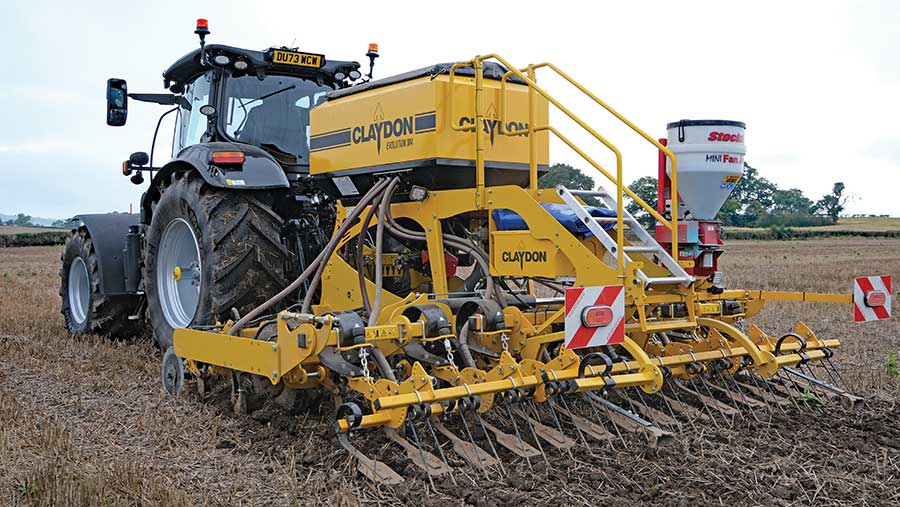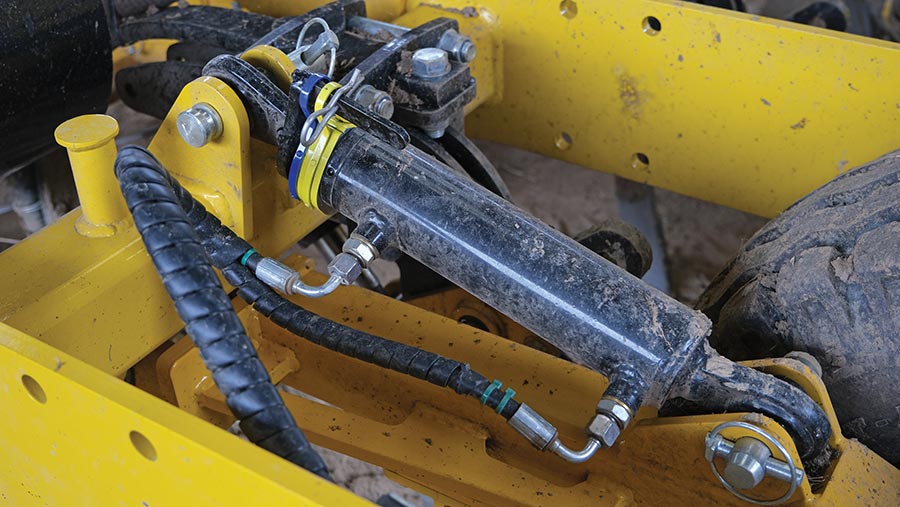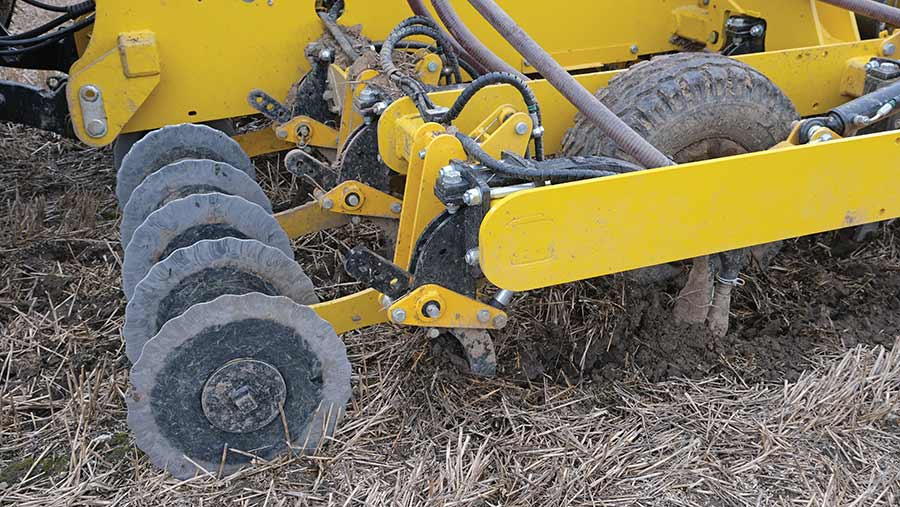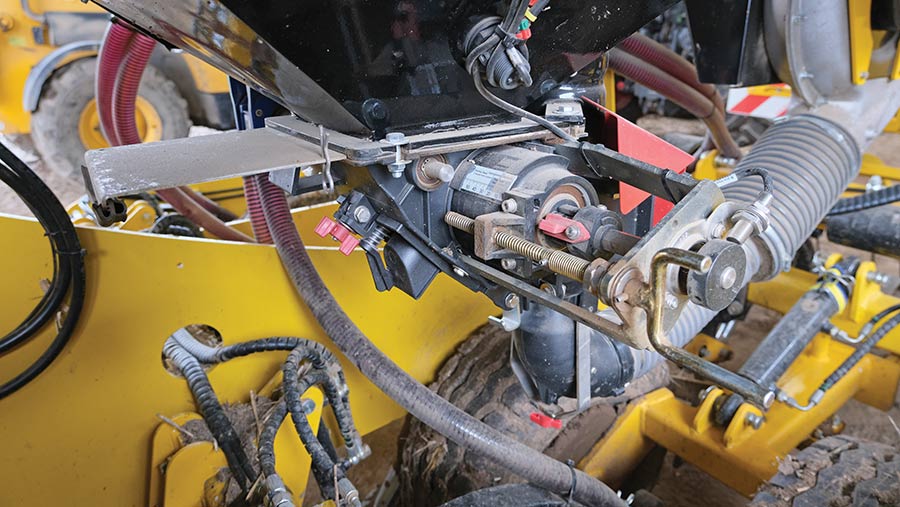Driver’s view: Claydon Evolution big improvement over Hybrid
 © James Andrews
© James Andrews Three years after investing in a 3m Claydon Hybrid to speed up crop establishment, Thomas Langley had picked up sufficient extra contracting work to find himself on the back foot again.
Upsizing was the obvious answer, so out went the rigid model in favour of a 4m folding machine.
Size wasn’t the only upgrade though, as the Suffolk maker has spent the intervening years lavishing the drill with updates and giving it a new moniker – Evolution.
To find out if the changes have been worthwhile, we caught up with Thomas as the newcomer was easing into its first season at his farm and contracting business in Eaton Constantine, Shropshire.
See also: Direct drills revisited: Mzuri Pro-Til 3T out, Avatar in
Thomas Langley’s Claydon Evolution M4
- Width/coulter spacing 4m/300mm
- Coulters Leading tine with 180mm A share
- Hopper 1,900 litres
- Price paid £66,000
Has it changed for the better?
The Hybrid was a great drill, but there was room for improvement. It seems like Claydon really listened to customers before it brought out the Evolution, as most issues have been sorted.
Moving to hydraulic depth adjustment is probably the most significant change, as the old system of manual top-links on all four wheels was a pain.
Not only was it time consuming to get round them all, but there was also always the odd seized one to make the job even more of a faff.
Now each has its own hydraulic ram with a series of colour-coded shims to dictate the depth, and there’s a handy reference chart printed inside the lid of the toolbox.
Cleverly, the rams are powered off the return feed from the hydraulic fan, as are the pre-emergence markers, meaning there’s no need to have an extra spool valve in play.
In fact, just two spools are required to run the drill – one for the fan and one for the folding of the wings.

The new hydraulic rams © James Andrews
The hopper is bigger too, up to 1,910 litres, which means I can comfortably fit two bags of barley seed in without having to run it close to empty.
The opening has also been made wider so both bags can be loaded at the same time. It sounds minor, but it saves quite a bit of time over a day.
Fitting a larger toolbox is a nice touch as there’s now space for everything I need on the drill, including the collapsible calibration tub.
On the old drill I had to carry some of this kit in the tractor cab, which would often get under my feet.
It’s also worth mentioning the fact that it now runs on much larger wheels, which make it travel better, and the rear paddle assembly has been given check chains to stop them bouncing on the road.
Did you opt for any extras?
I kept the main parts of the drill the same as the last one, so it has the standard leading tine which I set to work at 15mm (6in).
This is followed by a 180mm A-share with two outlets that spread the seed across the width of the cultivated strip.
There are several options for what comes behind, but I think the sprung paddles are by far the best on our predominantly clay loam soils.
These are positioned either side of the row and they do a great job of bashing clods and flicking soil back over the seed.
They are most effective when you’re travelling at a decent speed, so I tend to drill at about 12kph.
At the rear there’s a levelling harrow with swept tines that does a bit more seed covering and levels off the surface.
The main difference is the fact that I’ve now got a row of discs at the front of the drill for cutting through trash and reducing the amount of soil disturbance.
I needed to spec these in order to get a grant to help pay for it, but they have been useful, particularly in long stubble where they prevent it hooking around the front tines.

The added front discs © James Andrews
What made you choose a Claydon?
I’d spent years using a 3m Kuhn power harrow disc drill which delivered consistent results, but it was time consuming and used lots of fuel, particularly with the heavy cultivation we were doing first.
When the ground was dry, this would be carried out using a 3m Sumo Trio and, when it was wetter, we’d turn to a five-furrow Kuhn plough. Both of these and the power harrow got through plenty of expensive wearing metal too.
On top of this, my partner Hannah and I would be working flat out for weeks to cover the ground, so we eventually decided that there had to be a better way.
I don’t think I’ve ever pondered over a machinery buying decision so much, as I wanted to get it right first time and I wasn’t prepared to lose yield as a result of making the change.
Strip till seemed the safest single-pass option, so I soon narrowed my search down to Mzuri or Claydon.
I liked the look of the Mzuri, but it was complicated, expensive, higher maintenance and needed lots of power up front. The Claydon is so simple in comparison, which really appealed.
Before committing to buy anything, Claydon sent over a contractor with one and we planted half the field with it, and half with our system. The yield ended up being identical on both halves and the Claydon side had lower grassweed pressure.
That was enough to convince me it was the way to go, particularly with the fuel, time and wearing metal savings we’d be getting.
How have the drills performed?
The Evolution is nicer to use and has some neat additions, but it essentially does the same job as the Hybrid. That’s good though because the old drill worked perfectly well.
Four seasons in and yields are holding up well, fuel use is a fraction of what it used to be and soil structure is improving. Plus it’s a one-man job, and when I’m working at 12kph I can easily cover 25ha in a day.
If we had bigger fields, it would be a good bit higher than this, but the largest we’ve got is 9ha and the smallest is 1.6ha, so I’m forever drilling headlands.
Our ground suits the drill well, but you have to be patient and only go when it’s relatively dry on the surface. This hasn’t been a problem until now, but the rain we’ve had this autumn means I haven’t yet drilled any of our own fields.
I still think there’s a good chance I’ll get drilled up though, as it’s so quick when I am able to get going.
As for the tractor on the front, this is a 240hp Case Puma CVX, which is well on top of the job – Claydon reckons 200hp is enough. It also uses very little fuel, at about 13 litres/ha.
What could be improved?
The main downside of the 4m Evolution is that the front centre tine sits right under the metering system.
This makes it difficult to adjust the depth shims and change the share, as well as making it a faff to empty the hopper.
On the old one I was able to manoeuvre a bag in, but for this one I’ve had to purchase a sheet to drop it onto with a neck to fill a bag.
This does a good job of catching the seed, but there’s still a risk of soil contamination as it cascades down.

The metering system © James Andrews
The Accord-style metering system also isn’t as clever as the unit on the Kuhn drill, which could remember settings when I switched between different seed rates.
On this one, you need to calibrate it every time I make a change.
It’s also worth mentioning that seeding depth isn’t as consistent as a drill with coulters mounted on a parallel linkage.
The fact that they’re fixed on a box-section frame with two staggered rows means some will sit shallower than others as the ground undulates.
To avoid seed ending up with seed on top of the soil, I end up setting them slightly deeper than I’d ideally like.
Emergence can be a little uneven as a result, but it’s a small price to pay for the simplicity, low running costs and working speed.
Likes and gripes
Likes
- Reliable establishment
- Easy depth control
- Simple to maintain
- Cheap to run
Gripes
- Difficult to empty hopper
- Slightly uneven seeding depth
- Controller can’t store past calibrations

